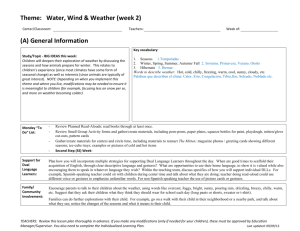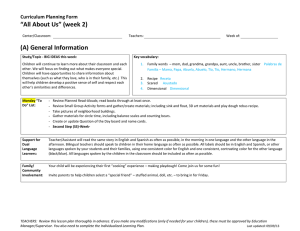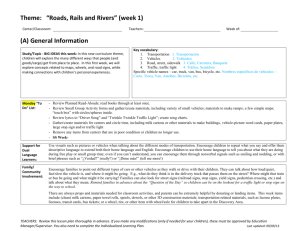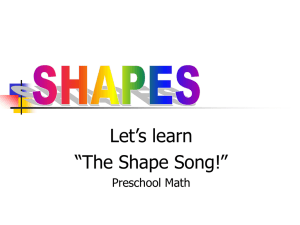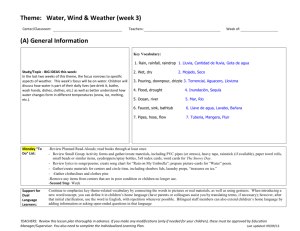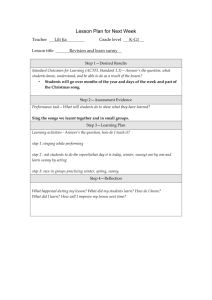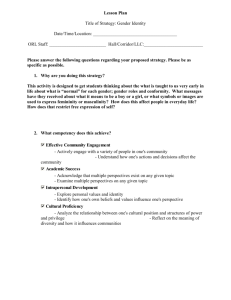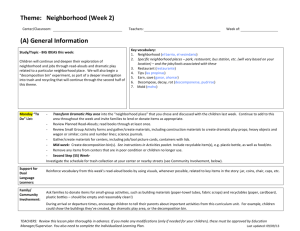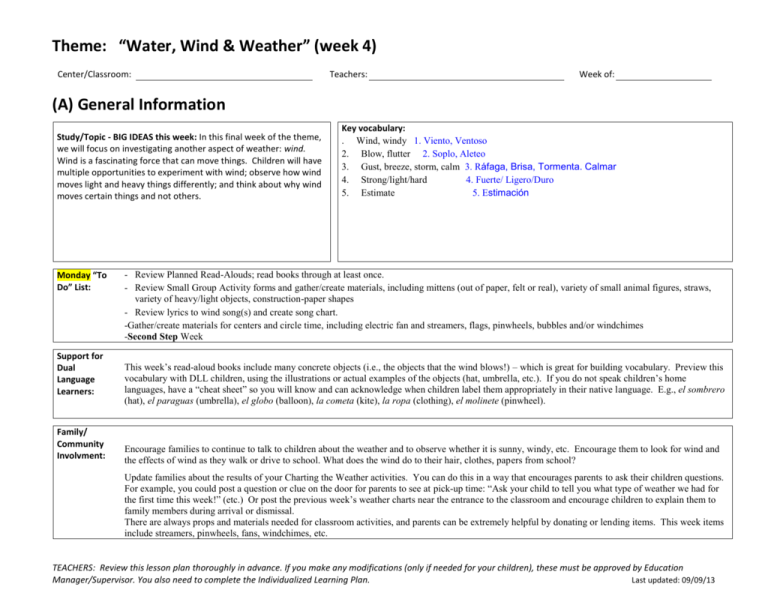
Theme: “Water, Wind & Weather” (week 4)
Center/Classroom:
Teachers:
Week of:
(A) General Information
Study/Topic - BIG IDEAS this week: In this final week of the theme,
we will focus on investigating another aspect of weather: wind.
Wind is a fascinating force that can move things. Children will have
multiple opportunities to experiment with wind; observe how wind
moves light and heavy things differently; and think about why wind
moves certain things and not others.
Monday “To
Do” List:
Support for
Dual
Language
Learners:
Family/
Community
Involvment:
Key vocabulary:
. Wind, windy 1. Viento, Ventoso
2. Blow, flutter 2. Soplo, Aleteo
3. Gust, breeze, storm, calm 3. Ráfaga, Brisa, Tormenta. Calmar
4. Strong/light/hard
4. Fuerte/ Ligero/Duro
5. Estimate
5. Estimación
- Review Planned Read-Alouds; read books through at least once.
- Review Small Group Activity forms and gather/create materials, including mittens (out of paper, felt or real), variety of small animal figures, straws,
variety of heavy/light objects, construction-paper shapes
- Review lyrics to wind song(s) and create song chart.
-Gather/create materials for centers and circle time, including electric fan and streamers, flags, pinwheels, bubbles and/or windchimes
-Second Step Week
This week’s read-aloud books include many concrete objects (i.e., the objects that the wind blows!) – which is great for building vocabulary. Preview this
vocabulary with DLL children, using the illustrations or actual examples of the objects (hat, umbrella, etc.). If you do not speak children’s home
languages, have a “cheat sheet” so you will know and can acknowledge when children label them appropriately in their native language. E.g., el sombrero
(hat), el paraguas (umbrella), el globo (balloon), la cometa (kite), la ropa (clothing), el molinete (pinwheel).
Encourage families to continue to talk to children about the weather and to observe whether it is sunny, windy, etc. Encourage them to look for wind and
the effects of wind as they walk or drive to school. What does the wind do to their hair, clothes, papers from school?
Update families about the results of your Charting the Weather activities. You can do this in a way that encourages parents to ask their children questions.
For example, you could post a question or clue on the door for parents to see at pick-up time: “Ask your child to tell you what type of weather we had for
the first time this week!” (etc.) Or post the previous week’s weather charts near the entrance to the classroom and encourage children to explain them to
family members during arrival or dismissal.
There are always props and materials needed for classroom activities, and parents can be extremely helpful by donating or lending items. This week items
include streamers, pinwheels, fans, windchimes, etc.
TEACHERS: Review this lesson plan thoroughly in advance. If you make any modifications (only if needed for your children), these must be approved by Education
Manager/Supervisor. You also need to complete the Individualized Learning Plan.
Last updated: 09/09/13
(B) Materials to Enhance Children’s Play
Blocks
Dramatic Play
Add:
Flags or pennants
Fan (review safety expectations with children – i.e. not
to be touched)
Pictures of windmills or pictures showing windy days
Add:
Pillow cases for laundry line
Toys and Games
Add:
Multicolored paper shapes (see “Sorting Shapes”
small-group activity)
Animal figurines & mittens (see “How Many Will
Fit?” small-group activity)
Art
Library/Writing
Discovery/Science
Add:
“Windy Pictures.” Have The Wind Blew and/or Gilberto
and the Wind available (protected in plastic!) and ask
children to notice how the illustrator showed us it was
windy. Invite children to paint “windy” pictures by
using lines or movement to represent the wind.
AND/OR Put light-brown paper at the easel with white,
black and brown paint, and encourage children to get
ideas from the illustrations in Gilberto and the Wind.
Add:
Read-aloud books for this week
Optional: sequencing cards for The Wind Blew (see
Read-Aloud guide)
Add:
Pinwheels
Straws to blow through; variety of heavy/ light
objects to move (see “Make Your Own Wind” smallgroup activity)
Sand and Water
Music and Movement
Add:
Straws to blow through
Paper boats (if using water table) or very thin layer of
sand (for sand table)
** Review safety rules about blowing through straws
Optional: show Sid Wind Investigation clip (see “Make
Your Own Wind” small-group activity) to give children
ideas about using these materials
Add:
Outdoors
Computers
Add:
Cooking
Pinwheels, streamers, bubbles, wind chimes (any/all that are available)
Attach a flag, streamer or windsock in an appropriate location for children to observe how windy it is each day.
Ask questions such as could the wind blow a leaf today? a hat? a rock? (etc.)
Extension: Create a pictorial scale to show how strong the wind is each day – for example, a flag or tree
bending different amounts to represent more wind.
© 2012 Acelero, Inc. All Rights Reserved. Uses are subject to the limitations set forth in your user agreement. Your right to use these materials is contingent upon remaining a current
SARGE subscriber with Acelero, Inc.
(C) Group Experiences
Monday
Arrival
Opening
Circle
Movement
Relaxation
Transitions
Closing
Circle
Tuesday
Wednesday
Thursday
Friday
Arrival: Attendance graph
Arrival: Attendance graph
Arrival: Attendance graph
Arrival: Attendance graph
Morning Circle:
Welcome song & one other
Morning Circle:
Welcome song & one other
Morning Circle:
Welcome song & one other
Morning Circle:
Welcome song & one other
Chart Weather
Chart Weather
Chart Weather
SS Puppet Script
Review daily schedule and
rules now and throughout
the day
Review daily schedule and
rules now and throughout
the day
Transition: QOTD: What
did the wind move on your
way to school? Have
visuals. (Hair/ Clothes/
Leaves/ Nothing?) Have
children answer during
arrival or transition,
charting with
whiteboard/pocket chart/etc
Transition: SS Brain
Builder-
Chart Weather &
Review** After tallying
today’s weather, look back
at ALL FOUR weeks of
theme and make
comparisons. E.g., how
many days in all was it
sunny? What week had the
most rainy days? etc.
Discussion: What do we
know about wind? Ask
guiding questions such as:
Can you see wind? How do
you know it’s windy? What
happens in the wind? What
might be fun to do on a
windy day? If desired,
create a KWL chart, listing
children’s ideas in the K
column and adding to the W
column (What do we want
to know about wind?), time
permitting.
Review daily schedule and
rules now and throughout
the day
Music/Movement: Finger
play – “I See the Wind”
“Move Like the Wind” (see
below)& one other
movement
Music/Movement: Choose
at least 2
Relaxation:
Transition:
Closing Circle:
Goodbye song
Review daily schedule and
rules now and throughout
the day
Transition:
Music/Movement: : SS
Song & one other
SS Skill Activity-
Relaxation:
Relaxation:
Transition: SS Brain
Builder-
Transition: Move like the
wind to the next activity
Transition:
Music/Movement: SS Song
and “Noisy Wind”
Closing Circle:
Review QOTD results with
the full group, counting
each column and writing
the numeral.
Sung to: "The Farmer in the dell"
I like the noisy wind,
I like the noisy wind.
It roars and mutters
Closing Circle:
Goodbye song
© 2012 Acelero, Inc. All Rights Reserved. Uses are subject to the limitations set forth in your user agreement. Your right to use these materials is contingent upon remaining a current
SARGE subscriber with Acelero, Inc.
Monday
Tuesday
(voice loud, then softer)
And Shakes the shutters.
(shake hands Tambourine-Style.)
I like the noisy wind
I Like the Noisy wind,
I like the noisy wind.
It flaps the flag
(flap your arms back and forth)
And rustles my bag.
(rub hands together briskly)
I like the noisy wind.
Wednesday
Thursday
Friday
Goodbye song
*Point out words that
rhyme
Relaxation:
Transition:
Closing Circle:
Goodbye song
ReadAlouds
Group 1: Gilberto and the
Wind by Marie Hall Ets
(initial reading: focus on
understanding plot, making
connections to The Wind
Blew)
Group 2: The Wind Blew
SmallGroup
Activity
Group 1: Sorting Shapes
Group 2: Make Your Own
Wind
Group 1: The Wind Blew
Group 2: Gilberto and the
Wind by Marie Hall Ets
(initial reading: focus on
understanding plot, making
connections to The Wind
Blew)
Group 1: SS Story and
Discussion
Group 2: SS Book-
Group 1: Make Your Own
Wind
Group 1: How Many Will
Fit?
Group 2: Sorting Shapes
Group 2: SS Skill Activity-
Group 1: SS BookGroup 2: SS Story and
Discussion-
Group 1: SS Skill ActivityGroup 2: How Many Will
Fit?
© 2012 Acelero, Inc. All Rights Reserved. Uses are subject to the limitations set forth in your user agreement. Your right to use these materials is contingent upon remaining a current
SARGE subscriber with Acelero, Inc.
Monday
Tuesday
Wednesday
Special
Activities
Tangible
Acknowledgement System:
Playing with the Wind”:
Children will explore the
effects of wind (simulated
by an electric fan).
Materials: standing fan;
streamers, tissue paper or
light fabric for each child.
Review safety rules and
ensure you have enough
space. Allow children to
stand in the “wind” and
away from it and notice the
effect on their streamers.
What happens when they
face into/ away from the
wind? What happens if the
wind is light, vs. strong?
What happens to their own
clothing, hair, etc.?
Imitate the wind: Encourage
children to move like the
wind. Add variations –
move like a strong wind, a
light breeze, etc. Encourage
children to suggest others.
Outside
Inclement Weather Plan:
Thursday
Friday
Discussion: What have we
learned about wind? If you
began a KWL chart earlier
this week, complete it by
adding to the L column.
© 2012 Acelero, Inc. All Rights Reserved. Uses are subject to the limitations set forth in your user agreement. Your right to use these materials is contingent upon remaining a current
SARGE subscriber with Acelero, Inc.
Individual Child Planning Form
School Readiness Goal
Focus Domain(s)
Physical
Approaches to
Learning
Language &
Literacy
Cogn./ Gen.
Knowledge
Name
Soc-Emotional
Focus
Date
Child’s
Week of:
Strategy/Activity
Focus TS
GOLD
Objective(s)
Why Chosen?
(IFSP, TS Gold Report,
family input, conference
goal, etc.)
NOTE: Children with similar needs may benefit from
differentiated instruction (e.g. during small-group activity).
You can use the “Small Group” column at right to make notes
about possible groupings.
Example: 1. Routine – activity, state how you are
individualizing for this child.
CHECK when
implemented
Teachers:
Possible small-group?
Center/Classroom:
1.
2.
3.
1.
2.
3.
1.
© 2012 Acelero, Inc. All Rights Reserved. Uses are subject to the limitations set forth in your user agreement. Your right to use these materials is contingent upon remaining a current
SARGE subscriber with Acelero, Inc.
2.
3.
1.
2.
3.
1.
2.
3.
1.
2.
3.
1.
2.
3.
IFSP Child Planning
Child’s Name
IFSP Goals
Classroom Plan: What’s the Activity/Who’s Supporting the Child
© 2012 Acelero, Inc. All Rights Reserved. Uses are subject to the limitations set forth in your user agreement. Your right to use these materials is contingent upon remaining a current
SARGE subscriber with Acelero, Inc.
*Please review all IFSP plans including Speech Only to ensure implementation of all classroom goals.
*For speech goals the what/who would be: Directed by the Speech Language Therapist
© 2012 Acelero, Inc. All Rights Reserved. Uses are subject to the limitations set forth in your user agreement. Your right to use these materials is contingent upon remaining a current
SARGE subscriber with Acelero, Inc.

